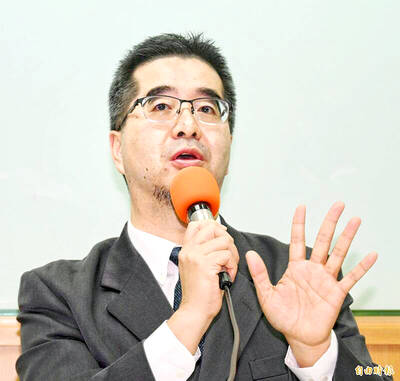Registering a drone with the government is to cost NT$50 come October, when the Regulations on Drones (遙控無人機管理規則) six-month introductory period comes to an end, the Civil Aeronautics Administration (CAA) said yesterday.
The regulations were implemented on March 31, but to encourage drone owners to fly their drones legally and safely, the agency did not charge a registration fee, and allowed them to take directly the written and flying tests for a professional drone operator certificate without having to obtain a regular operator certificate first, Flight Standards Division Director Clark Lin (林俊良) said.
“However, the Regulations of Drones require the agency to start charging registration fees after implementing the new regulations for six months, so we have to change the pricing scheme for registration and all operators must take the test for a regular drone operator certificate first,” Lin said.
They would not be able to take the test for a professional drone operator certificate until they have a regular drone operator certificate, and they must wait at least one month before taking the professional test, Lin added.
Drone registration is valid for two years and drone owners must register their aircraft again before their current registration expires, Lin said.
In addition, as of this month, people who want to take the drone operator certificate tests can only specify one time period they are available to take the written test, not two as before, to ensure a more efficient use of examination rooms, Lin said.
As of Tuesday last week, the nation had 33,723 registered drones, of which 5,110 belong to legal entities and 28,613 are owned by individuals, CAA statistics showed.
More than 2,000 drone operator certificates were issued between March 31 and Tuesday last week, including 212 student operator certificates, 491 regular operator certificates and 1,316 professional operator certificates.
A total of 206 legal entities have secured professional drone operator certificates during the past three months: 67 government agencies, eight schools, five private associations and 126 companies.
The CAA has received 308 applications for permission to fly drones, of which nearly 76 percent were for aerial photography, and about 11.7 percent were for monitoring or surveying a target, Lin said.
Other applications included training and presentation (3.9 percent), pesticide and fertilizer spraying (1.62 percent) and testing new aircraft (1.95 percent).
The map of airspace open to drones was updated on June 19, and would continue to be updated every three months initially, Lin said.
“We will update the information every six months once drone operators and government agencies become familiar with the relevant regulations,” he said.
There are 10 venues for the drone flying tests, he added.

The Coast Guard Administration (CGA) yesterday said it had deployed patrol vessels to expel a China Coast Guard ship and a Chinese fishing boat near Pratas Island (Dongsha Island, 東沙群島) in the South China Sea. The China Coast Guard vessel was 28 nautical miles (52km) northeast of Pratas at 6:15am on Thursday, approaching the island’s restricted waters, which extend 24 nautical miles from its shoreline, the CGA’s Dongsha-Nansha Branch said in a statement. The Tainan, a 2,000-tonne cutter, was deployed by the CGA to shadow the Chinese ship, which left the area at 2:39pm on Friday, the statement said. At 6:31pm on Friday,

The Chinese People’s Liberation Army Navy’s (PLAN) third aircraft carrier, the Fujian, would pose a steep challenge to Taiwan’s ability to defend itself against a full-scale invasion, a defense expert said yesterday. Institute of National Defense and Security Research analyst Chieh Chung (揭仲) made the comment hours after the PLAN confirmed the carrier recently passed through the Taiwan Strait to conduct “scientific research tests and training missions” in the South China Sea. China has two carriers in operation — the Liaoning and the Shandong — with the Fujian undergoing sea trials. Although the PLAN needs time to train the Fujian’s air wing and

Taiwanese celebrities Hank Chen (陳漢典) and Lulu Huang (黃路梓茵) announced yesterday that they are planning to marry. Huang announced and posted photos of their engagement to her social media pages yesterday morning, joking that the pair were not just doing marketing for a new show, but “really getting married.” “We’ve decided to spend all of our future happy and hilarious moments together,” she wrote. The announcement, which was later confirmed by the talent agency they share, appeared to come as a surprise even to those around them, with veteran TV host Jacky Wu (吳宗憲) saying he was “totally taken aback” by the news. Huang,

The American Institute in Taiwan (AIT) put Taiwan in danger, Ma Ying-jeou Foundation director Hsiao Hsu-tsen (蕭旭岑) said yesterday, hours after the de facto US embassy said that Beijing had misinterpreted World War II-era documents to isolate Taiwan. The AIT’s comments harmed the Republic of China’s (ROC) national interests and contradicted a part of the “six assurances” stipulating that the US would not change its official position on Taiwan’s sovereignty, Hsiao said. The “six assurances,” which were given by then-US president Ronald Reagan to Taiwan in 1982, say that Washington would not set a date for ending arm sales to Taiwan, consult